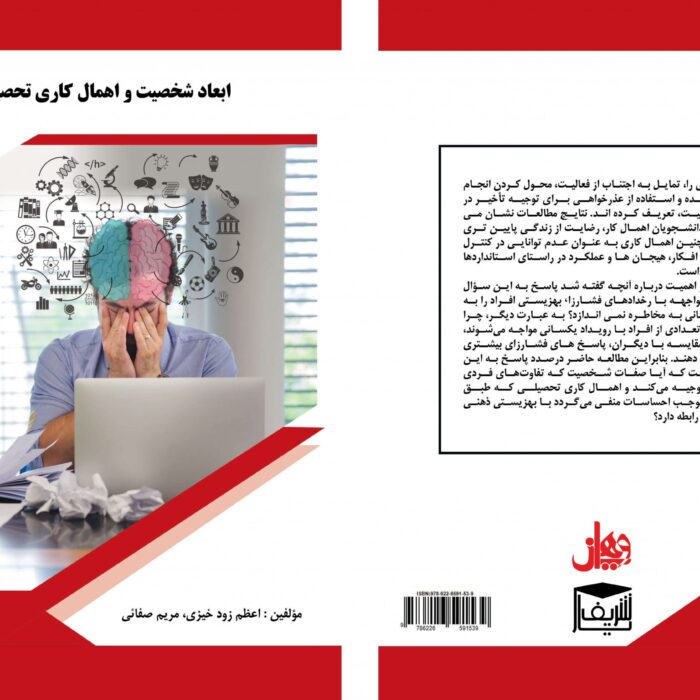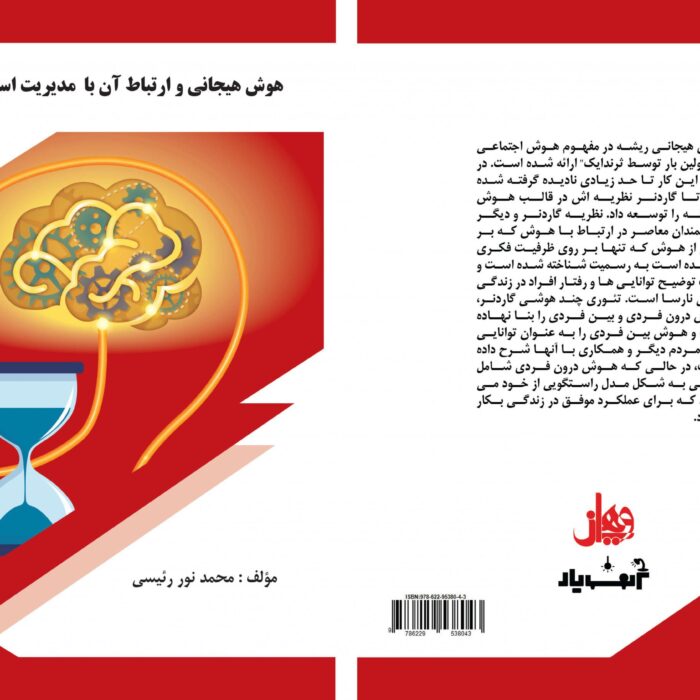کتاب OCCUPATIONAL STRESS IN THE WORKPLACE
۲۶۷,۰۰۰ تومان قیمت اصلی: ۲۶۷,۰۰۰ تومان بود.۱۷۳,۵۵۰ تومانقیمت فعلی: ۱۷۳,۵۵۰ تومان.
| تعداد صفحات | 80 |
|---|---|
| شابک | 978-620-7-46155-4 |
| انتشارات |

معرفی کتاب: “Occupational Stress in the Workplace”
📚 کتابی جامع در زمینه استرس شغلی و مدیریت آن
“Occupational Stress in the Workplace” یک اثر علمی و کاربردی است که به طور جامع به بررسی استرس شغلی، علل بروز آن و تأثیرات آن بر افراد و سازمانها میپردازد. این کتاب به مدیران، کارکنان، مشاوران منابع انسانی، و پژوهشگران کمک میکند تا با درک بهتری از استرس شغلی، روشهای مؤثر برای کاهش آن و بهبود بهرهوری و سلامت روانی در محیط کار را شناسایی کنند.
چرا این کتاب را بخوانیم؟
✔ شناخت انواع استرس و تأثیرات آن بر عملکرد فردی و سازمانی
✔ یادگیری تکنیکها و استراتژیهای مدیریت استرس برای بهبود کارایی
✔ دریافت توصیههای کاربردی برای پیشگیری و کاهش استرس شغلی
✔ آشنایی با روشهای علمی اندازهگیری استرس و تحلیل پیامدهای آن
محتوای کتاب به تفصیل
🔹 مفاهیم و انواع استرس
کتاب با تعریف دقیق استرس و انواع آن آغاز میشود و سپس به استرس شغلی و ویژگیهای خاص آن پرداخته میشود. این مباحث به خوانندگان این امکان را میدهد که تفاوتهای میان استرسهای مختلف و ویژگیهای استرس شغلی را بشناسند.
🔹 مدیریت استرس
بخشهای مختلف کتاب به استراتژیها و مدلهای مختلف مدیریت استرس اختصاص دارد. این استراتژیها و تکنیکها شامل روشهای پیشگیری، مقابله و درمان استرس شغلی هستند که میتوانند در سطح فردی و سازمانی به کار گرفته شوند.
🔹 علل و عوامل مؤثر بر استرس شغلی
کتاب به بررسی عواملی چون بار کاری زیاد، فشار زمان، عدم رضایت شغلی و مشکلات ارتباطی در محیط کار که میتوانند منجر به استرس شغلی شوند، میپردازد.
🔹 پیامدهای استرس شغلی بر عملکرد و سازمانها
این بخش از کتاب به تحلیل ارتباط میان استرس شغلی و عملکرد کاری فردی و سازمانی میپردازد. همچنین تأثیرات استرس بر سازمانها، بهرهوری، و جو کاری بررسی میشود.
🔹 مدیریت استرس در سطوح مختلف
کتاب به صورت جداگانه به مدیریت استرس در سطح فردی و سازمانی پرداخته و راهکارهایی برای بهبود شرایط کاری و مقابله با استرس ارائه میدهد.
🔹 استراتژیهای مقابله و پیشگیری از استرس شغلی
این بخش به معرفی تکنیکهای مؤثر در مقابله با استرس و پیشگیری از آن در محیطهای کاری مختلف میپردازد.
🔹 نتیجهگیری و پیشنهادات
در این بخش، کتاب به جمعبندی مفاهیم و ارائه پیشنهادات کاربردی برای بهبود مدیریت استرس در سازمانها و افزایش کیفیت زندگی کاری کارکنان پرداخته است.
مخاطبان این کتاب چه کسانی هستند؟
📌 مدیران منابع انسانی
📌 مشاوران سازمانی و روانشناسان صنعتی
📌 کارکنان و کارآفرینان در صنایع مختلف
📌 دانشجویان و محققان در زمینه علوم اجتماعی، روانشناسی و مدیریت
نتیجهگیری
کتاب “Occupational Stress in the Workplace” یک منبع جامع و علمی است که برای هر کسی که با چالشهای استرس شغلی مواجه است، مفید خواهد بود. این کتاب با ارائه رویکردهای علمی و کاربردی، راهکارهای موثری را برای مدیریت و کاهش استرس در محیط کار پیشنهاد میکند و به بهبود کیفیت زندگی حرفهای کمک میکند.
📘 پرسش و پاسخ درباره کتاب Occupational Stress in the Workplace
🔹 فصل 1: مفهوم استرس
❓ ۱. استرس چیست؟
🔹 استرس به حالت جسمی و روانی گفته میشود که فرد در برابر عوامل خارجی یا داخلی احساس فشار میکند. این فشار ممکن است ناشی از کار، روابط اجتماعی، یا مسائل فردی باشد.
❓ ۲. انواع استرس کدامند؟
🔹 استرس به دو نوع عمده تقسیم میشود: استرس مثبت (Eustress) که به افراد کمک میکند تا عملکرد بهتری داشته باشند، و استرس منفی (Distress) که میتواند منجر به مشکلات جسمی و روانی شود.
🔹 فصل 2: استرس شغلی
❓ ۳. استرس شغلی چیست؟
🔹 استرس شغلی به احساس فشار و تنش ناشی از فشارهای محیط کاری، مانند حجم کاری زیاد، تضادها در محیط کار، یا نارضایتی از شرایط کاری گفته میشود.
❓ ۴. چه عواملی موجب استرس شغلی میشوند؟
🔹 عواملی مانند حجم زیاد کار، نبود حمایت کافی از همکاران و مدیران، شرایط ناپایدار اقتصادی، تغییرات شغلی و نبود تعادل میان کار و زندگی میتوانند استرس شغلی را افزایش دهند.
🔹 فصل 3: مدیریت استرس
❓ ۵. مدیریت استرس چیست؟
🔹 مدیریت استرس به مجموعهای از تکنیکها و استراتژیها گفته میشود که به افراد کمک میکند تا استرس خود را کنترل کرده و آن را به شکلی سالم و مؤثر مدیریت کنند.
❓ ۶. استراتژیهای مدیریت استرس کدامند؟
🔹 استراتژیهای مدیریت استرس شامل تکنیکهای مختلفی همچون تمرینات تنفسی، ورزش، مشاوره و استفاده از استراتژیهای شناختی برای تغییر نحوه تفکر و واکنش به استرس هستند.
🔹 فصل 4: بررسی ادبیات تحقیق
❓ ۷. ادبیات تحقیق در مورد استرس شغلی شامل چه نکاتی است؟
🔹 در بررسی ادبیات تحقیق، به مطالعات قبلی در مورد انواع استرس شغلی، عوامل ایجاد آن، تأثیرات آن بر عملکرد فردی و سازمانی، و روشهای مدیریت آن پرداخته میشود.
❓ ۸. چگونه استرس شغلی اندازهگیری میشود؟
🔹 استرس شغلی میتواند از طریق ارزیابیهای روانسنجی، نظرسنجیها و مصاحبهها، و همچنین بررسی علائم جسمی و روانی فرد اندازهگیری شود.
🔹 فصل 5: علل استرس شغلی
❓ ۹. علل اصلی استرس شغلی چیست؟
🔹 عوامل مختلفی میتوانند باعث استرس شغلی شوند، از جمله فشار کاری زیاد، تضادهای بین همکاران یا مدیران، نبود منابع و حمایت کافی، و شرایط نامساعد محیط کاری.
❓ ۱۰. ارتباط بین استرس شغلی و عملکرد کاری چیست؟
🔹 استرس شغلی میتواند تأثیر منفی بر عملکرد کاری داشته باشد، از جمله کاهش کیفیت کار، کاهش تمرکز، و افزایش اشتباهات در انجام وظایف.
🔹 فصل 6: استراتژیهای مقابله با استرس شغلی
❓ ۱۱. چه استراتژیهایی برای مقابله با استرس شغلی در سطح فردی وجود دارد؟
🔹 افراد میتوانند با استفاده از استراتژیهایی مانند تمرینات آرامسازی، یادگیری تکنیکهای مدیریت زمان، انجام فعالیتهای ورزشی، و گفتگو با مشاوران، استرس شغلی خود را کاهش دهند.
❓ ۱۲. استراتژیهای مدیریت استرس در سطح سازمانی چیست؟
🔹 در سطح سازمانی، ایجاد یک محیط کاری حمایتی، کاهش فشارهای اضافی، برگزاری کارگاههای آموزشی مدیریت استرس، و ارائه پشتیبانی روانی برای کارکنان میتواند به کاهش استرس شغلی کمک کند.
🔹 فصل 7: نتیجهگیری و پیشنهادات
❓ ۱۳. نتایج این تحقیق چیست؟
🔹 تحقیق نشان داده است که استرس شغلی نه تنها بر عملکرد فردی تأثیر منفی میگذارد، بلکه میتواند موجب کاهش کارایی سازمانی و افزایش هزینههای درمانی شود.
❓ ۱۴. پیشنهادات و توصیهها برای کاهش استرس شغلی چیست؟
🔹 پیشنهادات شامل بهبود شرایط محیط کاری، ارائه دورههای آموزشی برای کارکنان در زمینه مدیریت استرس، و حمایتهای سازمانی بیشتر برای مقابله با استرس شغلی است.
📌 این پرسشها و پاسخها به شما کمک میکند تا با مفاهیم کلیدی کتاب Occupational Stress in the Workplace بیشتر آشنا شوید و آن را به خوبی درک کنید. 😊
| تعداد صفحات | 80 |
|---|---|
| شابک | 978-620-7-46155-4 |
| انتشارات |
محصولات مشابه
-
کتاب تعادل زندگی و اختلال اعتیاد به کار
۴۹۲,۰۰۰ تومانقیمت اصلی: ۴۹۲,۰۰۰ تومان بود.۲۴۶,۰۰۰ تومانقیمت فعلی: ۲۴۶,۰۰۰ تومان. -
کتاب اثربخشی هیپنوتیزم بر دلهره و عزت نفس
۶۷۸,۰۰۰ تومانقیمت اصلی: ۶۷۸,۰۰۰ تومان بود.۲۳۷,۳۰۰ تومانقیمت فعلی: ۲۳۷,۳۰۰ تومان. -
کتاب ابعاد شخصیت و اهمال کاری تحصیلی
۳۳۶,۰۰۰ تومانقیمت اصلی: ۳۳۶,۰۰۰ تومان بود.۱۸۴,۸۰۰ تومانقیمت فعلی: ۱۸۴,۸۰۰ تومان. -
کتاب هوش هیجانی و ارتباط آن با مدیریت استرس و زمان
۲۲۸,۰۰۰ تومانقیمت اصلی: ۲۲۸,۰۰۰ تومان بود.۱۷۱,۰۰۰ تومانقیمت فعلی: ۱۷۱,۰۰۰ تومان.












